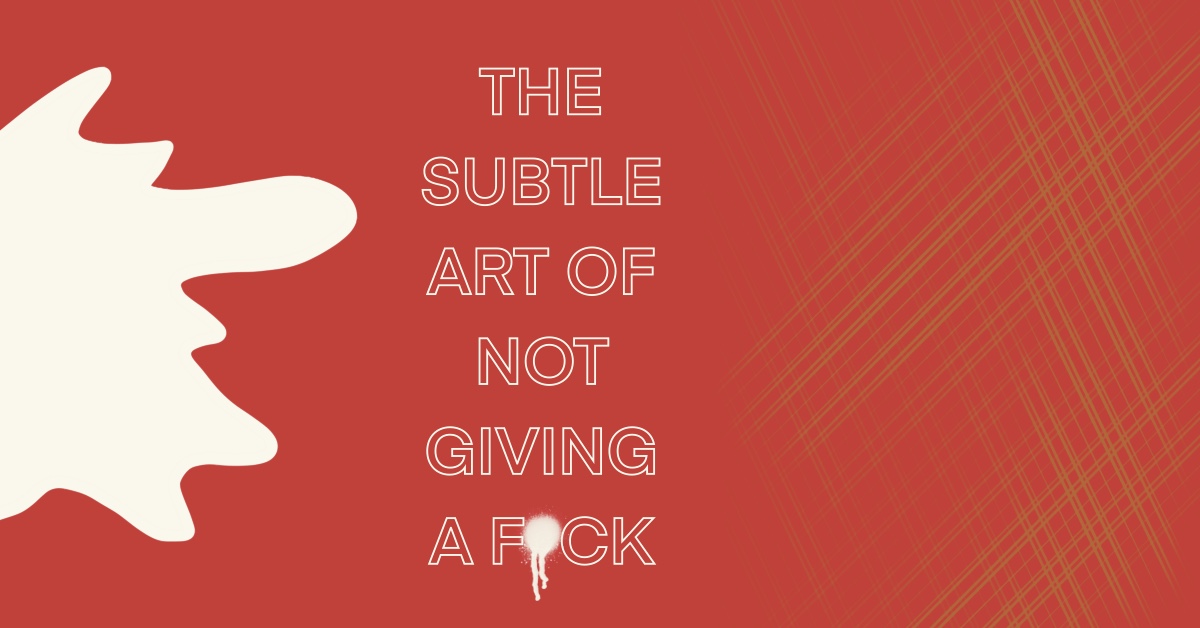Suffering with purpose: good and bad values
Have you ever read a book from start to finish more than once? If so, what made you want to read it a second or third time? Perhaps it was the author’s writing style, their way of telling a captivating story that resonated with you, or the topic was just intriguing enough that you couldn’t look away from the page.
For me, that book was The Subtle Art of Not Giving a F*ck by Mark Manson. A few months into the Covid-19 pandemic, I found myself struggling with keeping friendships afloat. My extroverted personality came to a halt—and with it, thoughts of negative self-reflection poured into my mind. I felt shitty, and I couldn’t understand why. I wanted to stop caring and distract myself, and that’s when I picked up Manson’s book.
The Subtle Art of Not Giving a F*ck argues that life will always have problems associated with it. The secret to living a good life isn’t about ignoring those problems and carrying on without a care. Instead, it’s about focusing on our own personal values and how these values can help us address those problems. The fourth chapter, “The Value of Suffering,” was the chapter that most stood out to me.
“The Value of Suffering” opens with the story of Hiroo Onoda, a World War II Imperial Japanese Army intelligence officer: “On December 26, 1944, [Onoda] was deployed to the small island of Lubang in the Philippines. His orders were to slow the United States’ progress as much as possible, to stand and fight at all costs, and to never surrender. Both he and his commander knew it was essentially a suicide mission.” Manson sets the stage with directness: a Japanese soldier gets sent into war and is told to never surrender.
Indeed, Onoda never surrendered even after the war ended. He wasn’t aware that the war was over after the US dropped atomic bombs on the cities of Hiroshima and Nagasaki. Attempts were made to inform him, but “Once again, Onoda refused to believe that the information was real. Once again, he believed the airdrop to be a trick by the Americans. Once again, he and his men stood and continued to fight.” Manson uses parallelism to portray Onoda’s core values: honesty and obedience to authority—otherwise known as the “Bushido” code. Onoda hid in the jungle for five more years after the war ended, becoming an urban legend in Japan.
However, it wasn’t long until a Japanese adventurer named Norio Suzuki challenged himself to rescue Japan’s urban legend: “Sure, search parties conducted by the Japanese, Philippine, and American governments had not been able to find Onoda; local police forces had been scavenging the jungle for almost thirty years with no luck; thousands of leaflets had met with no response—but fuck it, this deadbeat, college-dropout hippie was going to be the one to find him.” Manson later describes that Suzuki screamed Onoda’s name in the jungle and found him within four days.
Manson’s voice and use of the semicolon draws the reader’s attention. He uses witty and relatable language, like writing “f*ck it,” or calling a Japanese adventurer a “deadbeat, college-dropout hippie” to keep his readers engaged. He also uses the semicolon as a hanging bridge to highlight all the efforts the governments made over the years as compared to a single man shouting Onoda’s name. These writing techniques add humour to the piece. But how is the story of Onoda tied to the title of this chapter; what is the value of his suffering?
“These men both chose how they wished to suffer,” Manson writes. “Hiroo Onoda chose to suffer for loyalty to a dead empire. Suzuki chose to suffer for adventure, no matter how ill-advised. To both men, their suffering meant something; it fulfilled some greater cause. And because it meant something, they were able to endure it, or perhaps even enjoy it.” Manson makes the point that suffering means nothing unless it’s done with a purpose. He argues that suffering is inevitable and shifts the perspective from “How do I stop suffering?” to “Why am I suffering—for what purpose?”
Manson also uses rhetorical questions to guide the reader to a specific conclusion: “Why do you feel angry? Is it because you failed to achieve some goal? Why do you feel lethargic and uninspired? Is it because you don’t think you’re good enough?” More specifically, he uses them to help the reader understand the root of their overwhelming emotions.
Manson ends the chapter by defining good and bad values. According to him, good values are defined as being “reality-based, socially constructive, and immediate and controllable.” Whereas bad values are defined as “superstitious, socially destructive, and not immediate and controllable.” He describes examples of bad values as “feeling good all the time, always being the center of attention, not being alone, [and] being liked by everybody.” This is where it all clicked for me.
Manson argues that Onoda’s value of complete loyalty and service to the Japanese empire was a bad one: “It created really shitty problems for Hiroo—namely, he got stuck on a remote island where he lived off bugs and worms for thirty years… Despite the fact Hiroo saw himself as a success, and despite the fact he lived up to his metrics, I think we can all agree that his life really sucked.”
Before the pandemic, I was used to chasing that feel-good emotion all the time by hanging out with friends or going out with family. I was not used to being alone. I was used to being the centre of attention as a subject matter expert at the job I had at the time. All of that was ripped apart. I defined myself by those values, but reading this chapter helped me reflect and amend them.
“The Value of Suffering” helped me realize that humans act based on their values. And sure, Google could’ve told me this without having read this book—but that’s not the point. It was Manson’s writing that helped me analyze and correct my negative behaviour. I don’t want to live under an illusion like Onoda did. I want to be real with myself. The Subtle Art of Not Giving a F*ck, more specifically, “The Value of Suffering,” helped me take that first step during a time of need.
Managing Editor (Volume 50); Copy Editor (August-November, Volume 50); Features Editor (Volume 48) — Jaros graduated with a Professional Writing and Communications major, and a Physics and Mathematics double minor in 2021. He previously worked as the Features Editor for Volume 48. In his free time, you can catch Jaros working out at his small-town gym, curating playlists, or suffering as he defends the latest phase of the Marvel Cinematic Universe. You can connect with him on Instagram or LinkedIn.


